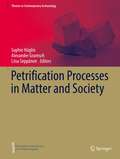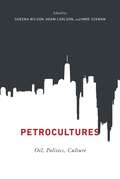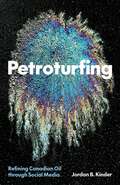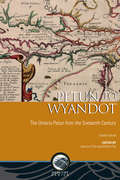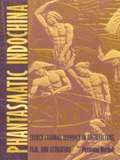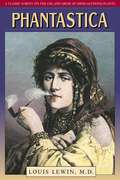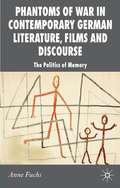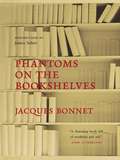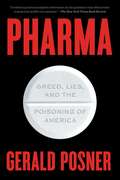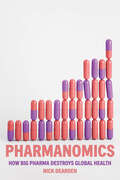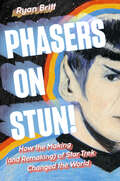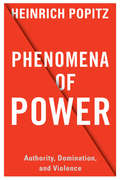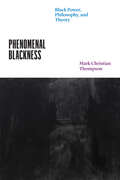- Table View
- List View
Petrification Processes in Matter and Society (Themes in Contemporary Archaeology)
by Sophie Hüglin Alexander Gramsch Liisa SeppänenPetrification is a process, but it also can be understood as a concept. This volume takes the first steps to manifest, materialize or “petrify” the concept of “petrification” and turn it into a tool for analyzing material and social processes. The wide array of approaches to petrification as a process assembled here is more of a collection of possibilities than an attempt to establish a firm, law-generating theory. Divided into three parts, this volume’s twenty-plus authors explore petrification both as a theoretical concept and as a contextualized material and social process across geological, prehistoric and historic periods. Topics connecting the various papers are properties of materials, preferences and choices of actors, the temporality of matter, being and becoming, the relationality between actors, matter, things and space (landscape, urban space, built space), and perceptions of the following generations dealing with the petrified matter, practices, and social relations. Contributors to this volume study specifically whether particular processes of petrification are confined to the material world or can be seen as mirroring, following, triggering, or contradicting changes in social life and general world views. Each of the authors explores – for a period or a specific feature – practices and changes that led to increased conformity and regularity. Some authors additionally focus on the methods and scrutinize them and their applications for their potential to create objects of investigation: things, people, periods, in order to raise awareness for these or to shape or “invent” categories. This volume is of interest to archaeologists, geologists, architectural historians, conservationists, and historians.
Petrocultures: Oil, Politics, Culture
by Sheena Wilson, Adam Carlson and Imre SzemanA wide-ranging interdisciplinary study of oil and energy culture.
Petrolia: The Landscape of America's First Oil Boom (Creating the North American Landscape)
by Brian BlackThis award-winning history provides a fascinating look at the Civil War era oil boom in western Pennsylvania and its devastating impact on the region. In Petrolia, Brian Black offers a geographical and social history of a region that was not only the site of America’s first oil boom but was also the world’s largest oil producer between 1859 and 1873. Against the background of the growing demand for petroleum throughout and immediately following the Civil War, Black describes Oil Creek Valley’s descent into environmental hell. Known as “Petrolia,” the region of northwestern Pennsylvania charged the popular imagination with its nearly overnight transition from agriculture to industry. But so unrestrained were these early efforts at oil drilling, Black writes, that “the landscape came to be viewed only as an instrument out of which one could extract crude.” In a very short time, Petrolia was a ruined place—environmentally, economically, and to some extent even culturally. Black gives historical detail and analysis to account for this transformation.Winner of the Paul H. Giddens Prize in Oil History from Oil Heritage Region, Inc.
Petrolipalynology
by Dexin Jiang Eleanora I. Robbins Yongdong Wang Huiqiu YangThis book addresses the principles and methods for determining petroleum source rocks based on fossil spores and pollen. Studying petroliferous basins in China, we discovered that there are often as many as three different sources of the microfossils: the source rocks, the rocks along the pathway, and the reservoir rocks. Therefore, fossil spores, pollen and algae from inland and coastal shelf petroliferous basins are analyzed and illustrated to show this complex process. Furthermore, the organic origin theory of oil is proven and environmental characteristics for hydrocarbon source-rock formation are discussed. Along with the geochronical and geographic distribution of non-marine petroleum source rocks in China, the mechanisms of petroleum migration following the pathways to the reservoirs are investigated. It will be a valuable reference work as well as a textbook for a wider research areas ranging from stratigraphy, palynology, palaeontology and petroleum geology.
Petroturfing: Refining Canadian Oil through Social Media
by Jordan B. KinderHow social media has become a critical tool for advancing the interests of the Canadian oil industry Petroturfing presents an incisive look into how Canada&’s pro-oil movement has leveraged social media to rebrand the extractive economy as a positive force. Adapting its title from the concept of astroturfing, which refers to the practice of disguising political and corporate media campaigns as grassroots movements, the book exposes the consequences of this mutually informed relationship between social media and environmental politics. Since the early 2010s, an increasingly influential network of pro-oil groups, organizations, and campaigns has harnessed social media strategies originally developed by independent environmental organizations in order to undermine resistance to the fossil fuel industry. Situating these actions within the broader oil culture wars that have developed as an outgrowth of contemporary right-wing media, Petroturfing details how this coalition of groups is working to reform the public view of oil extraction as something socially, economically, and ecologically beneficial. By uncovering these concerted efforts to influence the &“energy consciousness,&” Jordan B. Kinder reveals the deep divide between Canada&’s environmentally progressive reputation and the economic interests of its layers of government and private companies operating within its borders. Drawing attention to the structures underlying online political expression, Petroturfing highlights the limitations of social media networks in the work of promoting environmental justice and contributing to a more equitable future.
Pets and Domesticity in Victorian Literature and Culture: Animality, Queer Relations, and the Victorian Family (Routledge Studies in Nineteenth Century Literature)
by Monica FlegelAddressing the significance of the pet in the Victorian period, this book examines the role played by the domestic pet in delineating relations for each member of the "natural" family home. Flegel explores the pet in relation to the couple at the head of the house, to the children who make up the family’s dependents, and to the common familial "outcasts" who populate Victorian literature and culture: the orphan, the spinster, the bachelor, and the same-sex couple. Drawing upon both animal studies and queer theory, this study stresses the importance of the domestic pet in elucidating normative sexuality and (re)productivity within the familial home, and reveals how the family pet operates as a means of identifying aberrant, failed, or perverse familial and gender performances. The family pet, that is, was an important signifier in Victorian familial ideology of the individual family unit’s ability to support or threaten the health and morality of the nation in the Victorian period. Texts by authors such as Clara Balfour, Juliana Horatia Ewing, E. Burrows, Bessie Rayner Parkes, Anne Brontë, George Eliot, Frederick Marryat, and Charles Dickens speak to the centrality of the domestic pet to negotiations of gender, power, and sexuality within the home that both reify and challenge the imaginary structure known as the natural family in the Victorian period. This book highlights the possibilities for a familial elsewhere outside of normative and restrictive models of heterosexuality, reproduction, and the natural family, and will be of interest to those studying Victorian literature and culture, animal studies, queer studies, and beyond.
Petun to Wyandot: The Ontario Petun from the Sixteenth Century (Mercury Series)
by Charles GarradIn Petun to Wyandot, Charles Garrad draws upon five decades of research to tell the turbulent history of the Wyandot tribe, the First Nation once known as the Petun. Combining and reconciling primary historical sources, archaeological data and anthropological evidence, Garrad has produced the most comprehensive study of the Petun Confederacy. Beginning with their first encounters with French explorer Samuel de Champlain in 1616 and extending to their decline and eventual dispersal, this book offers an account of this people from their own perspective and through the voices of the nations, tribes and individuals that surrounded them.Through a cross-reference of views, including historical testimony from Jesuits, European explorers and fur traders, as well as neighbouring tribes and nations, Petun to Wyandot uncovers the Petun way of life by examining their culture, politics, trading arrangements and legends. Perhaps most valuable of all, it provides detailed archaeological evidence from the years of research undertaken by Garrad and his colleagues in the Petun Country, located in the Blue Mountains of Central Ontario. Along the way, the author meticulously chronicles the work of other historians and examines their theories regarding the Petun's enigmatic life story.
Peña Nieto: el gran montaje
by Jenaro VillamilUna radiografía crítica sobre Enrique Peña Nieto que incluye un análisis pormenorizado de la construcción mediática de la "carrera política" del priista, las turbias alianzas detrás de su candidatura, y una amplia reflexión en torno a los posibles escenarios postelectorales de 2012. Con Peña Nieto llegó a la presidencia toda una red de intereses. Autor de Si yo fuera presidente (2009) y El sexenio de Televisa (2010), Jenaro Villamil, reportero, periodista de investigación y experto en medios, ahora hace frente a la consumación del proceso mediático que ha seguido puntualmente desde 2005: el triunfo de Enrique Peña Nieto en las pasadas elecciones presidenciales. A pesar de ser el político con mayor nivel de exposición en los medios de comunicación, Peña Nieto sigue siendo un desconocido para la mayoría de los observadores y de sus propios votantes. En este sentido el presente libro formúlala radiografía crítica más completa del hombre que gobernará el país de diciembre de 2012 a diciembre de 2018. Nos explica cómo fue proyectado políticamente por Arturo Montiel, cómo lo fue desde su campaña para gobernador, y cómo, ejerciendo el poder, respondió a la red de intereses que, finalmente, lo ha llevado a la presidencia. La historia de esta red, sus alcances, ambiciones y expedientes negros están descritos aquí al calor de una de las campañas más polémicas de las últimas décadas. Igualmente se da cuenta de la forma en que la maquinaria electoral del PRI se echó a andar en 2012 siguiendo el modelo ya probado en las elecciones del Estado de México, un modelo que bordea la ilegalidad y que ha motivado denuncias y protestas de un importante segmento de la sociedad mexicana. Además de exponer el papel jugado por las encuestas en la pasada elección-papel que forma parte de la operación encubierta que hizo ganar a Peña Nieto, afirma Villamil-, se analiza la influencia de los ex presidentes Zedillo y Salinas al mismo tiempo que se plantean los futuros escenarios de la restauración priista. El gran montaje ha empezado, sostiene el autor; falta saber si su polémica victoria en las urnas, considerada como una imposición por buena parte del electorado, superará el desencanto mexicano ante una transición a la democracia que sigue sin realizarse.
Pflege: Theorie und Praxis im Dialog (Gesundheit und Gesellschaft)
by Heike Ohlbrecht Astrid SeltrechtSeit der COVID19-Pandemie werden die Pflegeberufe in der öffentlichen Wahrnehmung in neuer Form wertgeschätzt und als systemrelevant diskutiert. Der Pflegealltag hat sich seit der Corona-Pandemie durch kurzfristiges Krisenmanagement und langfristiger Ungewissheit der weiteren Entwicklung verändert. Diesen Spannungsbogen nimmt das Buch in den Blick und geht hierbei folgenden Fragen nach:Deckt sich die kollektive Aufwertung, die Pflege sei systemrelevant, mit der subjektiven Einschätzung der einzelnen Pflegefachkraft? Welche neuen Herausforderungen begegnen den Pflegefachkräften? Wie erleben sie ihren veränderten Berufsalltag? Wie gehen sie mit der permanenten Bedrohung durch Ansteckung bis hin zu einem erneuten Lockdown um? Darüber hinaus ist bislang unklar, inwieweit die COVID19-Pandemie Auswirkungen auf die Berufswahlentscheidung und -motivation nimmt.
Pflegefachpersonen als pflegende Angehörige: Eine qualitative Studie zum Erleben der Doppelrolle
by Anke JähnkeIn diesem Open-Access-Buch stehen Pflegefachpersonen im Zentrum, die zugleich pflegende Angehörige sind. Als professionell Pflegende verfügen sie über Fachwissen, pflegefachliche Kompetenzen und Kenntnisse zum Versorgungssystem. Als pflegende Angehörige sind sie persönlich betroffen. Die qualitative Studie fokussiert auf das Erleben der Doppelrolle als beruflich Pflegende und zugleich pflegende Angehörige. Sind dies ‚zwei Paar Schuhe‘? Ausgehend von einer Literaturrecherche und der Sekundäranalyse von Interviewdaten wurden episodische Interviews mit 15 Interviewpartner*innen geführt. Die Datenanalyse verdeutlicht ihre Aufgaben im Krankheitsverlauf, welche Entwicklungen sie durchlaufen und ihre Erfahrungen in der Doppelrolle. Die Studie zeigt, dass die Befragten über ein Repertoire von Handlungsoptionen verfügen, die sie im Umgang mit Fachpersonen der Gesundheitsversorgung nutzen. Die gewonnenen Erkenntnisse werden in einem Modell gebündelt, das ihre Positionierung als pflegende Angehörige und zugleich Pflegefachperson im Versorgungskontext veranschaulicht.
Phallacy: Life Lessons from the Animal Penis
by Emily WillinghamA wry look at what the astonishing world of animal penises can tell us about how we use our own.The fallacy sold to many of us is that the penis signals dominance and power. But this wry and penetrating book reveals that in fact nature did not shape the penis--or the human attached to it--to have the upper...hand. Phallacy looks closely at some of nature's more remarkable examples of penises and the many lessons to learn from them. In tracing how we ended up positioning our nondescript penis as a pulsing, awe-inspiring shaft of all masculinity and human dominance, Phallacy also shows what can we do to put that penis back where it belongs. Emphasizing our human capacities for impulse control, Phallacy ultimately challenges the toxic message that the penis makes the man and the man can't control himself. With instructive illustrations of unusual genitalia and tales of animal mating rituals that will make you particularly happy you are not a bedbug, Phallacy shows where humans fit on the continuum from fun to fatal phalli and why the human penis is an implement for intimacy, not intimidation.
Phantasmatic Indochina: French Colonial Ideology in Architecture, Film, and Literature
by Panivong NorindrThis reflection on colonial culture argues for an examination of "Indochina" as a fictive and mythic construct, a phantasmatic legacy of French colonialism in Southeast Asia. Panivong Norindr uses postcolonial theory to demonstrate how French imperialism manifests itself not only through physical domination of geographic entities, but also through the colonization of the imaginary. In this careful reading of architecture, film, and literature, Norindr lays bare the processes of fantasy, desire, and nostalgia constituent of French territorial aggression against Indochina.Analyzing the first Exposition Coloniale Internationale, held in Paris in 1931, Norindr shows how the exhibition's display of architecture gave a vision to the colonies that justified France's cultural prejudices, while stimulating the desire for further expansionism. He critiques the Surrealist counter-exposition mounted to oppose the imperialist aims of the Exposition Coloniale, and the Surrealist incorporation and appropriation of native artifacts in avant-garde works. According to Norindr, all serious attempts at interrogating French colonial involvement in Southeast Asia are threatened by discourse, images, representations, and myths that perpetuate the luminous aura of Indochina as a place of erotic fantasies and exotic adventures. Exploring the resilience of French nostalgia for Indochina in books and movies, the author examines work by Malraux, Duras, and Claudel, and the films Indochine, The Lover, and Dien Bien Phu.Certain to impact across a range of disciplines, Phantasmatic Indochina will be of interest to those engaged in the study of the culture and history of Vietnam, Cambodia, Thailand, and Laos, as well as specialists in the fields of French modernism, postcolonial studies, cultural studies, and comparative literature.
Phantastica: A Classic Survey on the Use and Abuse of Mind-Altering Plants
by Louis LewinLong out of print, this is a landmark study on narcotic and psychedelic substances by a world-renowned pharmacologist and toxicologist • The first book to bring non-judgmental scientific insights to the use of drugs around the world• Provides detailed information on all major drugs of the time, including opium, cocaine, heroin, cannabis, peyote, fly agaric, henbane, datura, alcohol, kava, betel, coffee, tea, cocoa, and tobacco• A book credited with starting an era of ethnobotany that continues to the present dayThe publication of Louis Lewin's Phantastica in 1924 began an era of ethnobotany that is still flourishing today. Until Lewin, books on the use of drugs were purely works of anthropology, concerned with how people used these plants, rather than how the plants produced their famous effects. Lewin, a world-renowned pharmacologist and toxicologist, was fascinated by both, and Phantastica was the first book to bring scientific insights to a survey of the use of drugs around the world. Lewin traveled extensively and acquired an astonishing variety of knowledge, reflected in this book, which provides detailed information on all major drugs of the time, including opium, cocaine, heroin, cannabis, peyote, fly agaric, henbane, datura, alcohol, kava, betel, coffee, tea, cocoa, and, of course, tobacco. For thirty years ethnobotanists have bemoaned the fact that Phantastica has been impossible to find; now this landmark work is once again available.
Phantom Armies of the Night: The Wild Hunt and the Ghostly Processions of the Undead
by Claude LecouteuxAn exploration of the many forms of the ancient myth of the Wild Hunt and its influence in pagan and early Christian Europe • Recounts the myriad variations of this legend, from the Cursed Huntsman and King Herla to phantom armies and vast processions of sinners and demons • Explains how this belief was an integral part of the pagan worldview and was thus employed by the church to spread Christian doctrine • Reveals how the secret societies of medieval Europe reenacted these ghostly processions for soul travel and prophecies of impending death Once upon a time a phenomenon existed in medieval Europe that continuously fueled local lore: during the long winter nights a strange and unknown troop could be heard passing outside over the land or through the air. Anyone caught by surprise in the open fields or depths of the woods would see a bizarre procession of demons, giants, hounds, ladies of the night, soldiers, and knights, some covered in blood and others carrying their heads beneath their arms. This was the Wild or Infernal Hunt, the host of the damned, the phantom army of the night--a theme that still inspires poets, writers, and painters to this day. Millennia older than Christianity, this pagan belief was employed by the church to spread their doctrine, with the shapeshifters' and giants of the pagan nightly processions becoming sinners led by demons seeking out unwary souls to add to their retinues. Myth or legend, it represents a belief that has deep roots in Europe, particularly Celtic and Scandinavian countries. The first scholar to fully examine this myth in each of its myriad forms, Claude Lecouteux strips away the Christian gloss and shows how the Wild Hunt was an integral part of the pagan worldview and the structure of their societies. Additionally, he looks at how secret societies of medieval Europe reenacted these ghostly processions through cult rituals culminating in masquerades and carnival-like cavalcades often associated with astral doubles, visions of the afterlife, belief in multiple souls, and prophecies of impending death. He reveals how the nearly infinite variations of this myth are a still living, evolving tradition that offers us a window into the world in which our ancestors lived.
Phantoms of War in Contemporary German Literature, Films and Discourse: The Politics of Memory
by Anne FuchsPhantoms of War in Contemporary German Literature, Films and Discourse offers an up-to-date and comprehensive analysis of fundamental shifts in German cultural memory. Focusing on the resurgence of family stories in fiction, autobiography and in film, this study challenges the institutional boundaries of Germany's memory culture that have guided and arguably limited German identity debates. Essays on contemporary German literature are complemented by explorations of heritage films and museum discourse. Together these essays put forward a compelling theory of family narratives and a critical evaluation of generational discourse.
Phantoms on the Bookshelves
by Jacques BonnetThis enchanting study on the art of living with books considers how our personal libraries reveal our true nature: far more than just places, they are living labyrinths of our innermost feelings. The author, a lifelong accumulator of books both ancient and modern, lives in a house large enough to accommodate his many thousands of books, as well as overspill from the libraries of his friends. While his musings on the habits of collectors past and present are learned, witty and instructive, his advice on cataloguing may even save the lives of those whose books are so prodigiously piled as to be a hazard... The Phantoms on the Bookshelves ranges from classical Greece to contemporary Iceland, from Balzac and Moby Dick to Google, offering up delicious anecdotes along the way. This elegantly produced volume will be a lasting delight to specialist collectors, librarians, bibliophiles and all those who treasure books.
Phantoms on the Bookshelves
by Jacques BonnetThis enchanting study on the art of living with books considers how our personal libraries reveal our true nature: far more than just places, they are living labyrinths of our innermost feelings. The author, a lifelong accumulator of books both ancient and modern, lives in a house large enough to accommodate his many thousands of books, as well as overspill from the libraries of his friends. While his musings on the habits of collectors past and present are learned, witty and instructive, his advice on cataloguing may even save the lives of those whose books are so prodigiously piled as to be a hazard... The Phantoms on the Bookshelves ranges from classical Greece to contemporary Iceland, from Balzac and Moby Dick to Google, offering up delicious anecdotes along the way. This elegantly produced volume will be a lasting delight to specialist collectors, librarians, bibliophiles and all those who treasure books.
Pharma: Greed, Lies, and the Poisoning of America
by Gerald PosnerAward-winning journalist and New York Times bestselling author Gerald Posner traces the heroes and villains of the trillion-dollar-a-year pharmaceutical industry and uncovers how those once entrusted with improving life have often betrayed that ideal to corruption and reckless profiteering—with deadly consequences. Pharmaceutical breakthroughs such as antibiotics and vaccines rank among some of the greatest advancements in human history. Yet exorbitant prices for life-saving drugs, safety recalls affecting tens of millions of Americans, and soaring rates of addiction and overdose on prescription opioids have caused many to lose faith in drug companies. Now, Americans are demanding a national reckoning with a monolithic industry. Pharma introduces brilliant scientists, in-corruptible government regulators, and brave whistleblowers facing off against company executives often blinded by greed. A business that profits from treating ills can create far deadlier problems than it cures. Addictive products are part of the industry&’s DNA, from the days when corner drugstores sold morphine, heroin, and cocaine, to the past two decades of dangerously overprescribed opioids. Pharma also uncovers the real story of the Sacklers, the family that became one of America&’s wealthiest from the success of OxyContin, their blockbuster narcotic painkiller at the center of the opioid crisis. Relying on thousands of pages of government and corporate archives, dozens of hours of interviews with insiders, and previously classified FBI files, Posner exposes the secrets of the Sacklers&’ rise to power—revelations that have long been buried under a byzantine web of interlocking companies with ever-changing names and hidden owners. The unexpected twists and turns of the Sackler family saga are told against the startling chronicle of a powerful industry that sits at the intersection of public health and profits. Pharma reveals how and why American drug companies have put earnings ahead of patients.
Pharmaceutical Industry and Public Policy in Post-reform India (Critical Political Economy of South Asia)
by Reji K. JosephThis book examines the impact of economic reforms in India on the pharmaceutical industry and access to medicines. It traces the changing production and trade pattern of the industry, research and development (R&D) preferences and strategies of Indian pharmaceutical firms, patent system alongside pricing policy measures and their shortcomings. It also analyses the public health financing system in India driven largely by out-of-pocket expenditure — about 60 per cent — and characterised by very high share of medicines in total health expenditure. A masterful insight into a topical area, the work will be indispensable to those working on pharmaceutical industry and public policy. It will be of interest to researchers, scholars, students, and policy-makers of economics, industrial policy, public policy, intellectual property rights and health financing.
Pharmanomics: How Big Pharma Destroys Global Health
by Nick DeardenInvestigative journalist Nick Dearden digs down into the way we produce our medicines and finds that Big Pharma is failing us, with catastrophic consequences.Big Pharma is more interested in profit than health. This was made clear as governments rushed to produce vaccines during the Covid pandemic. Behind the much-trumpeted scientific breakthroughs, major companies found new ways of gouging billions from governments in the West while abandoning the Global South. But this is only the latest episode in a long history of financialising medicine—from Purdue&’s rapacious marketing of highly addictive OxyContin through Martin Shkreli&’s hiking the price of a lifesaving drug to the 4.5 million South Africans needlessly deprived of HIV/AIDS medication. Since the 1990s, Big Pharma has gone out of its way to protect its property through the patent system. As a result, the business has focused not on researching new medicines but on building monopolies. This system has helped restructure our economy away from invention and production in order to benefit financial markets. It has fundamentally reshaped the relationship between richer and poorer countries, as the access to new medicines and the permission to manufacture them is ruthlessly policed. In response, Dearden offers a pathway to a fairer, safer system for all.
Pharmocracy: Value, Politics, and Knowledge in Global Biomedicine
by Kaushik Sunder RajanContinuing his pioneering theoretical explorations into the relationships among biosciences, the market, and political economy, Kaushik Sunder Rajan introduces the concept of pharmocracy to explain the structure and operation of the global hegemony of the multinational pharmaceutical industry. He reveals pharmocracy's logic in two case studies from contemporary India: the controversial introduction of an HPV vaccine in 2010, and the Indian Patent Office's denial of a patent for an anticancer drug in 2006 and ensuing legal battles. In each instance health was appropriated by capital and transformed from an embodied state of well-being into an abstract category made subject to capital's interests. These cases demonstrate the precarious situation in which pharmocracy places democracy, as India's accommodation of global pharmaceutical regulatory frameworks pits the interests of its citizens against those of international capital. Sunder Rajan's insights into this dynamic make clear the high stakes of pharmocracy's intersection with health, politics, and democracy.
Phasers on Stun!: How the Making (and Remaking) of Star Trek Changed the World
by Ryan BrittWritten with inside access, comprehensive research, and a down-to-earth perspective, Phasers on Stun! chronicles the entire history of Star Trek, revealing that its enduring place in pop culture is all thanks to innovative pivots and radical change. For over five decades, the heart of Star Trek&’s pro-science, anti-racist, and inclusive messaging has been its willingness to take big risks. Across thirteen feature films, and twelve TV series—including five shows currently airing or in production—the brilliance of Star Trek is in its endless ability to be rethought, rebooted, and remade. Author and Star Trek expert Ryan Britt charts an approachable and entertaining course through Star Trek history; from its groundbreaking origins amid the tumultuous 1960s, to its influence on diversifying the space program, to its contemporary history-making turns with LGBTQ+ representation, this book illuminates not just the behind-the-scenes stories that shaped the franchise but the larger meaning of the Final Frontier. Featuring over 100 exclusive interviews with actors and writers across all the generations, including Walter Koenig, LeVar Burton, Dorothy Fontana, Brent Spiner, Ronald D. Moore, Jeri Ryan, and many more, Britt gets the inside story on all things Trek, like Spock&’s evolution from red devil to the personification of logical empathy, the near failure to launch of The Next Generation in 1987, and how Trekkie outrage has threatened to destroy the franchise more than once. The book also dives deep with creators like Michael Chabon (co-creator of Star Trek: Picard) and Nicholas Meyer (director, The Wrath of Khan). These interviews extend to the bleeding edge of contemporary Star Trek, from Discovery to Picard to Lower Decks, and even the upcoming highly anticipated 2022 series, Strange New Worlds. For fans who know every detail of each Enterprise bridge, to a reader who has never seen a single minute of any Star Trek, this book aims to entertain, inform, and energize. Through humor, insight, archival research, and unique access, this journey through the Star Trek universe isn&’t just about its past but a definitive look at its future.
Phenomena of Power: Authority, Domination, and Violence (European Perspectives: A Series in Social Thought and Cultural Criticism)
by Heinrich PopitzIn Phenomena of Power, one of the leading figures of postwar German sociology reflects on the nature, and many forms of, power. For Heinrich Popitz, power is rooted in the human condition and is therefore part of all social relations. Drawing on philosophical anthropology, he identifies the elementary forms of power to provide detailed insight into how individuals gain and perpetuate control over others. Instead of striving for a power-free society, Popitz argues, humanity should try to impose limits on power where possible and establish counterpower where necessary.Phenomena of Power delves into the sociohistorical manifestations of power and breaks through to its general structures. Popitz distinguishes the forms of the enforcement of power as well as of its stabilization and institutionalization, clearly articulating how the mechanisms of power work and how to track them in the social world. Philosophically trained, historically informed, and endowed with keen observation, Popitz uses examples ranging from the way passengers on a ship organize deck chairs to how prisoners of war share property to illustrate his theory. Long influential in German sociology, Phenomena of Power offers a challenging reworking of one of the essential concepts of the social sciences.
Phenomenal Blackness: Black Power, Philosophy, and Theory (Thinking Literature)
by Mark Christian ThompsonThis unorthodox account of 1960s Black thought rigorously details the field’s debts to German critical theory and explores a forgotten tradition of Black singularity. Phenomenal Blackness examines the changing interdisciplinary investments of key mid-century Black writers and thinkers, including the growing interest in German philosophy and critical theory. Mark Christian Thompson analyzes this shift in intellectual focus across the post-war decades, placing Black Power thought in a philosophical context. Prior to the 1960s, sociologically oriented thinkers such as W. E. B. Du Bois had understood Blackness as a singular set of socio-historical characteristics. In contrast, writers such as Amiri Baraka, James Baldwin, Angela Y. Davis, Eldridge Cleaver, and Malcolm X were drawn to notions of an African essence, an ontology of Black being. With these perspectives, literary language came to be seen as the primary social expression of Blackness. For this new way of thinking, the works of philosophers such as Adorno, Habermas, and Marcuse were a vital resource, allowing for continued cultural-materialist analysis while accommodating the hermeneutical aspects of Black religious thought. Thompson argues that these efforts to reimagine Black singularity led to a phenomenological understanding of Blackness—a “Black aesthetic dimension” wherein aspirational models for Black liberation might emerge.
Phenomenal Blackness: Black Power, Philosophy, and Theory (Thinking Literature)
by Mark Christian ThompsonThis unorthodox account of 1960s Black thought rigorously details the field’s debts to German critical theory and explores a forgotten tradition of Black singularity. Phenomenal Blackness examines the changing interdisciplinary investments of key mid-century Black writers and thinkers, including the growing interest in German philosophy and critical theory. Mark Christian Thompson analyzes this shift in intellectual focus across the post-war decades, placing Black Power thought in a philosophical context. Prior to the 1960s, sociologically oriented thinkers such as W. E. B. Du Bois had understood Blackness as a singular set of socio-historical characteristics. In contrast, writers such as Amiri Baraka, James Baldwin, Angela Y. Davis, Eldridge Cleaver, and Malcolm X were drawn to notions of an African essence, an ontology of Black being. With these perspectives, literary language came to be seen as the primary social expression of Blackness. For this new way of thinking, the works of philosophers such as Adorno, Habermas, and Marcuse were a vital resource, allowing for continued cultural-materialist analysis while accommodating the hermeneutical aspects of Black religious thought. Thompson argues that these efforts to reimagine Black singularity led to a phenomenological understanding of Blackness—a “Black aesthetic dimension” wherein aspirational models for Black liberation might emerge.
